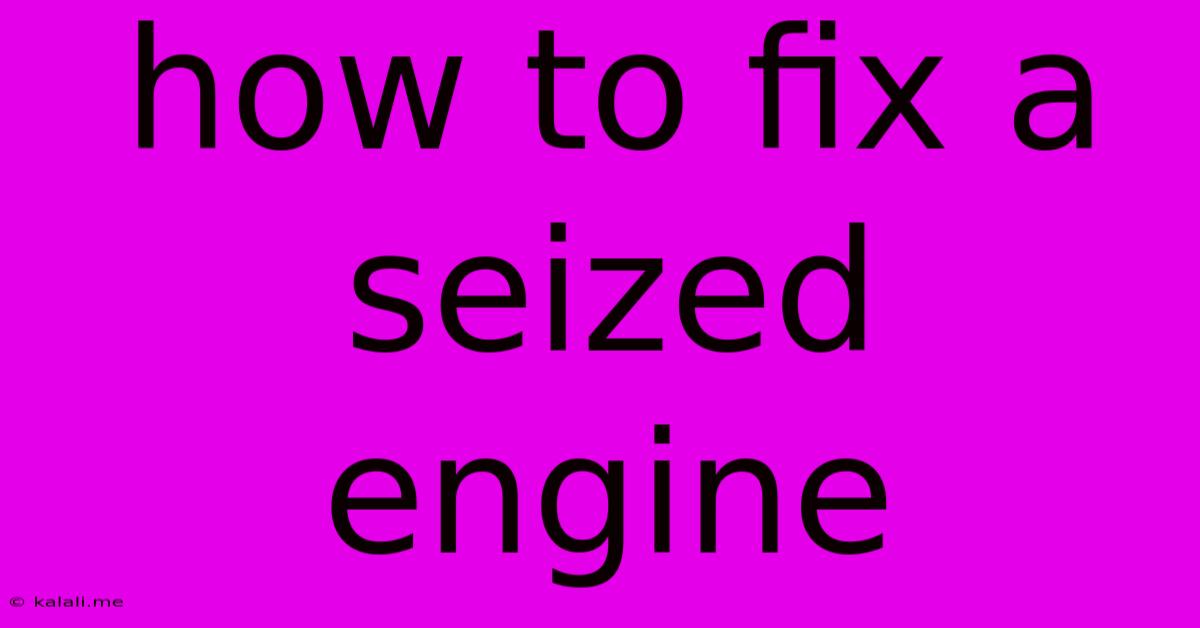How To Fix A Seized Engine
Kalali
May 23, 2025 · 4 min read

Table of Contents
How to Fix a Seized Engine: A Comprehensive Guide
A seized engine is a car owner's worst nightmare. This article will guide you through understanding why engines seize, diagnosing the problem, and exploring potential solutions, from simple fixes to major overhauls. Understanding the cause of the seizure is crucial for determining the best course of action. Knowing whether you're facing a minor issue or catastrophic engine failure will dictate the repair strategy.
What is a Seized Engine?
A seized engine occurs when the engine's internal components become locked, preventing the engine from turning over. This usually happens because of a lack of lubrication, resulting in metal-on-metal contact between moving parts like the crankshaft, connecting rods, and pistons. This friction generates extreme heat, leading to damage and immobility. The severity of the seizure can range from minor scoring to complete component failure.
Common Causes of Engine Seizure:
- Lack of Oil: This is the most frequent culprit. Low oil levels, infrequent oil changes, or the use of incorrect oil viscosity can starve the engine of lubrication, leading to seizing. Regular oil checks and maintenance are vital.
- Overheating: Excessive heat can cause the oil to break down, losing its lubricating properties and contributing to seizing. Issues with the cooling system, like a faulty radiator or thermostat, are often to blame.
- Contaminants in the Oil: Dirt, debris, or metal shavings in the engine oil can increase friction and wear, leading to seizing. Regular oil filter changes are key in preventing this.
- Water in the Oil: Water contamination, often resulting from a cracked cylinder head gasket or a blown head gasket, can severely compromise lubrication and cause seizing.
- Lack of Engine Break-in: New engines require a proper break-in period to allow the components to wear in properly and develop a protective layer of lubrication. Neglecting this can result in premature wear and seizing.
- Foreign Object Intrusion: In rare cases, a foreign object might enter the engine, causing immediate damage and seizing.
Diagnosing a Seized Engine:
Before attempting any repairs, it's crucial to properly diagnose the problem. Here's what to check:
- Attempt to turn the engine over: If the engine refuses to crank, this is a strong indicator of a seized engine. Try using a wrench on the crankshaft pulley to see if you can manually turn the engine.
- Check the oil level and condition: Low oil levels or milky, frothy oil indicates serious problems.
- Inspect for signs of overheating: Check the coolant level and look for signs of leaks or damage to the cooling system.
- Listen for unusual noises: Before the seizure, you might have heard knocking, grinding, or other abnormal sounds from the engine.
Fixing a Seized Engine: Options and Considerations
The repair needed depends heavily on the extent of the damage. Minor seizing might only require freeing up stuck components, while severe cases necessitate a complete engine rebuild or replacement.
- Minor Seizure (Possible Freeing): In some cases, with minimal damage, you might be able to free the seized components by adding penetrating oil and attempting to manually rotate the engine. This is risky and should only be attempted if you have experience with engine repair.
- Major Seizure (Overhaul or Replacement): If the damage is extensive, a complete engine overhaul or replacement is likely necessary. This involves disassembling the engine, replacing damaged parts (pistons, connecting rods, crankshaft bearings, cylinder head), and reassembling the engine. This requires specialized tools, expertise, and significant time investment.
- Professional Help: For most seized engines, seeking professional help from a qualified mechanic is highly recommended. They possess the expertise, tools, and diagnostic equipment to assess the damage accurately and perform the necessary repairs.
Prevention is Key:
Preventing engine seizure is far more cost-effective than dealing with the consequences. Here are some proactive steps:
- Regular oil changes: Follow the manufacturer's recommended oil change intervals.
- Use the correct oil: Use the oil viscosity recommended in your owner's manual.
- Monitor your engine temperature: Address overheating issues promptly.
- Regularly inspect your coolant system: Look for leaks and ensure proper functionality.
A seized engine is a serious issue, but understanding the causes, performing proper diagnosis, and choosing the right repair strategy can help you get back on the road. Remember that prevention is always the best approach. Regular maintenance and prompt attention to any unusual engine sounds or behaviors will significantly reduce the risk of experiencing this costly and frustrating problem.
Latest Posts
Latest Posts
-
Civicrm 0 Cannot Access Offset Of Type String On String
May 23, 2025
-
An Increasing Function With Zero Derivative Almost Evertwhere
May 23, 2025
-
Android Messenger Spell Check Not Working
May 23, 2025
-
One Second Delay In System Traffic
May 23, 2025
-
1 Foam Board Insulation In Between Block And Stud Wall
May 23, 2025
Related Post
Thank you for visiting our website which covers about How To Fix A Seized Engine . We hope the information provided has been useful to you. Feel free to contact us if you have any questions or need further assistance. See you next time and don't miss to bookmark.